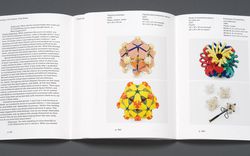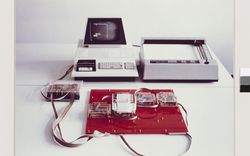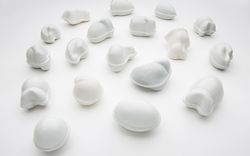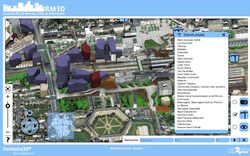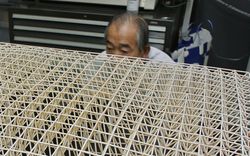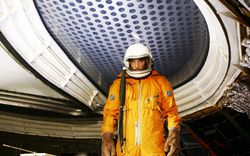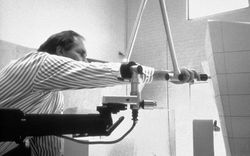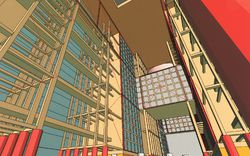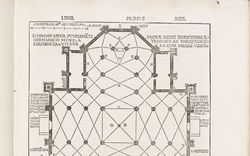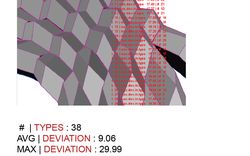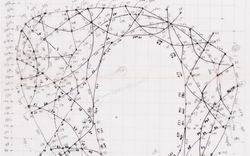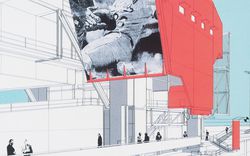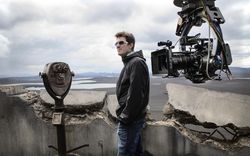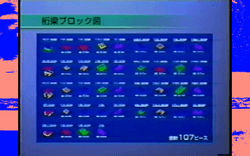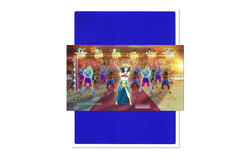Seeing the Digital World, in Hollywood
A conversation between Greg Lynn and Joseph Kosinski
- GL
- I’m interested in your experience with how software was used by architects and people in the entertainment industry.
- JK
- Well, I think that a big reason why I’m doing what I am now is the pure luck of being in the right place at the right time, which was GSAPP in the fall of 1996. I think this was the sweet spot in the digital revolution. If I had entered three years earlier, I would have missed it entirely, and if I had entered three years later, I would have missed the first wave that was the most interesting, when the digital was just penetrating the studios.
When I started at Columbia, the work in the paperless studios that you, Jesse Reiser, and others were doing was reserved for advanced students in their third year. I remember going into the dean’s office with Dean Di Simone—who ended up being my partner at KDLAB—during the first week of school and asking if we could enrol in one of the digital courses, because we knew that was where the action was. “Absolutely not,” we were told. First-year students could not touch a computer. At that point, you had to start your education with trace paper, T-squares, draft dots, and so on. So we were really disappointed, but halfway through the year they changed the policy because there was such a desire from the student body to get their hands on all this new software and hardware that was working its way in. In the second semester, the floodgates opened and we all enrolled in Introduction to Digital Design. We used a simple program called FormZ—I don’t know if people still use it, but it was a great place to start. We also started working with Photoshop, which I think at that point was in version 1 or version 2. There were one or two digital video cameras that you could check out. I feel very lucky, because I think Columbia was one of the few places, if not the only place, that was putting these tools in the hands of architecture students and letting us loose to play around with them.
The big transition point for me came during the second semester, when I enrolled in a studio led by Bill Mac Donald. I thought I was going to architecture school to learn how to be an architect, but instead my project with him was taking still frames from Chris Marker’s film La jetée and using those to generate a peer project. That was the first time I started to understand the intersection of film, architecture, and virtual space, and different ways of looking at how architecture could be conceived and understood. That’s what set me on the path to doing what I’m doing today.





Trailer for Tron: Legacy, 2010. Joseph Kosinski, director. © Disney
- GL
- What’s interesting about that period is that these things were taught as discipline-specific tools. Photoshop was taught as a conceptual tool and a design tool, rather than as an image-editing tool.
- JK
- Right. In the studios, all the software and hardware was there as a sandbox to play in, so you had to figure it out by yourself, by making it an intuitive process of discovery rather than a rote method of learning the software. Because of that, I think the results were much more interesting and unexpected and had a lot of the users’ personality in them. The variety of projects and the radically different approaches that we were all taking made for really interesting reviews. We were excited, but at the same time we were all asking ourselves, “What are we doing? What are we becoming? Are we learning architecture?” It was kind of scary, but in a good way, because I think so many people in my class and the classes around mine ended up finding very interesting careers that are on the edge of architecture, rather than right in the middle of it.
Read more
- GL
- And on a technical level, what were the hardware and software platforms you were exposed to, and how were they used?
- JK
- The first was FormZ, which was a basically a Boolean-driven solids program. You built up projects as volumes and then carved them away to create masses and voids. FormZ was a good introduction because it’s a very primal way of working. It’s like working with a piece of clay or a piece of wood.
- GL
- There was no visualization to speak of, right?
- JK
- No. It did hidden line. It did some shadows, but there was no animation at all. I think I get the distinction of doing the first FormZ animation at Columbia. By hand, I did six hundred snapshots of a model that I fully rotated and showed at the final, end-of-year show. I remember I got a lot of oohs and aahs.
At that time, everyone wanted to get their hands on what was being taught in the advanced courses—Alias or Softimage. Those were the two tracks you could choose. Softimage was a great animation program and Alias was a surface-modelling program that had come from the automobile and aerospace industries. It was completely different from FormZ; you could use spline-based methods to do all the sexy curves and topology that everyone was getting excited about. That’s what we were all striving for, and then in my second year, Maya came out. It blended the surface qualities of Alias with the animation tools of Softimage. It was what Hollywood was using, and when it finally made its way to Columbia, we were off to the races.
So those were the tools then. Everything ran on specialized Silicon Graphics machines. It felt very high-tech, very specialized. You felt very honoured to be able to sit down in front of the SGI machines, because they cost something like twenty thousand dollars. The Silicon Graphics lab was kept as a cool neon cave that was dark no matter what time of day it was. You would just hear the hum of the machines and everyone in there had headphones on, listening to Underworld and diving into the digital world. - GL
- After you graduated, how did all this technology fit into the visualization and conceptualization work you did for competitions and other projects?
- JK
- Well, I had done a couple of summer internships at architectural firms: one big corporate firm, and one small firm that was doing domestic or residential architecture. That gave me a glimpse of what the architectural profession was really like, which at those firms wasn’t anything at all like Columbia.
I did bathroom details and working drawings for a summer, so that was a first moment of realization for me that life after Columbia might not be like it seemed it would be when I was working in the studio. Right after I graduated, I had all these digital skills and tools that I had become fluent with and was trying to decide what to do next. I was fortunate that someone from the US Department of Energy contacted me about my final senior project, which had some DOE technology in it, and asked me if I would be interested in doing some work for them. This would be both design work and marketing work—essentially trying to sell power plants for 2015 or 2020. It was an opportunity to be my own boss and work directly for the client, and it was stuff I knew I could do, so I pulled in my friend Dean and we used the Department of Energy as our first client to form this company of two called KDLAB. We put out a website and a statement that we were interested in exploring the blurred boundaries between architecture, graphics, and film. I think a lot of people thought that was a hilarious thing to say in 1999, but it ended up working out for us.
We started taking on projects beyond architecture—branding, graphics, websites, and visualization. We also started to create our own films with our own narratives, which allowed me to create a reel that was noticed by advertising firms and companies like Nike. So I started doing work for these companies as a commercial director. - GL
- As KDLAB, I remember you did some work with Neil Denari. You worked on the Desert House film with him, right?
- JK
- Yes, actually Desert House was my design. It was my third-year final design project in Leslie Gill’s studio. And then in KDLAB, I took that design and made a first-person POV film about someone who wanders into the house and discovers it. The Desert House short was built on the one digital asset that was my own. The film went to RESFest, which was a big digital film festival at the time, and it was published in art and design magazines and fashion magazines. I think it was picked up like this because no one knew quite what it was. It was architecture, but it wasn’t real; it was a film.
- GL
- I remember the fact that it had a story and an experience built into it. It wasn’t some ridiculous fly-around.
- JK
- Exactly. It was a little bit of an indictment of the standard architectural fly-through—six minutes of flying around buildings. I did everything that was opposite to what a fly-through typically was. I made it hand held through motion control and I used editing. Essentially every shot was a series of clips rather than one interrupted thing, and it was seen as revolutionary. These are standard, basic film techniques that had been around for ninety years, but applied in the world of digital architecture, the result felt different and that’s maybe why the film was noticed. This was also when, for the first time, you could do photorealistic rendering. The film was done using the Mental Ray plugin for 3ds Max, which was a global lumination ray-tracing render. You put in a sun and a skydome and you got a photorealistic lighting solution as opposed to the normal point lights or the fake interaction of light in models. You could create a photorealistic scene, and I think that was also what made Desert House stand out at the time.
- GL
- It was very well calibrated in terms of the formal complexity, the rendering complexity, the landscape, and the lighting.
- JK
- I think it leveraged all the strengths of computer rendering at that time. It did all the things that CGI could do. It was set in a barren desert landscape; it wasn’t a jungle scene. It didn’t have any animated characters in it. It was all shot from first person, which avoided any sense of character. It was really just an exploration of a space, and sound design. So that was my first brush with rendering.
- GL
- That was right out of school.
- JK
- Yes. The project was designed in 1999 and I think I finished the film in the spring of 2001.
- GL
- Is that what you used for KDLAB, to get started?
- JK
- Yeah, it ended up being a calling card for KDLAB—certainly for the 3D or film side. So that got us some work, and then I followed it up with a second film called iSPEC, which was basically a fake Apple commercial. It starts in the first person; it’s someone navigating a menu in VR space, clicking through famous films, and they end up selecting The Shining. Then you get thrust into the Overlook Hotel, which was rendered in a photorealistic way, and you explore the hotel from a first-person POV and you can hear scenes from the movie happening in other rooms in the hotel. The reveal is that it’s for new Apple VR glasses that allow you to explore any film you want, as a participant. It was a short commercial. Slowly but surely, I developed a directing reel for KDLAB that attracted some bigger clients, like Nike.
- GL
- Let’s talk about your work with Preston Scott Cohen on the Eyebeam Atelier Museum competition, in 2001.
- JK
- Well, by that point, KDLAB had grown to about a dozen people. Every person in KDLAB had a different specialty. Dean was doing websites and interactives, I was focusing on the 3D and live-action film, and we had another person named Chris Hoxie, who was a student of Preston Scott Cohen and was an amazing CG lighter. He did renderings with Preston—Preston’s work looked stunning in white.
And so we had this little band of digital guys who all had their own specialties. Every job was different; we never did the same thing twice. For the Eyebeam competition we did everything from digitalization to designing the exhibition itself. It was a great time for us, when we could try a lot of different things and figure out what it is we were interested in, what we wanted to do with the rest of our lives. It was more of an artists’ collective—it certainly wasn’t a great business. - GL
- How involved were you with software companies at this time?
- JK
- A company called Discreet, which made 3ds Max, was heavily involved with KDLAB. They were always coming by and looking at how we were using the software, or just getting our stuff out, which they would then use as marketing material. We were really tight with those guys as they were developing the software.
- GL
- How did your KDLAB work influence what you’re doing now? High-fidelity 3D models were not necessarily the starting point for Hollywood.
- JK
- Architecture school was incredible preparation, not only on the technical side, which certainly helped with visual effects, but also in terms of the approach and the way of thinking about projects. Using a fundamental idea or a theme to inform every aspect of a project, from the very large to the very small—that approach works in film as it does in architecture. The idea of the blueprint and the script are very similar. The notion that no architect can build a building by himself, that it requires leading a team of hundreds if not thousands of people to complete the expression of an idea, is just as important in film.
Part of film is purely creative, but part of it is very technical and it does come down to logistics. There are just so many aspects to the job of directing. To me it is very similar to being an architect. So the architecture training allowed me to get an entry into the film business from a different angle, which is always a good thing. If you come in with just a film background, I think your frame of reference is very narrow. You’re always just trying to make another version of a Martin Scorsese film or something.
Columbia was the perfect place for me to be for my training. If I’d gone to Harvard or MIT, I think I would be doing something very different right now. So I was lucky to be there and to encounter the people who were teaching there at that time. You, Jesse, and Bernard Tschumi ran the place with a spirit of experimentation—it seemed like we could do anything.





Trailer for Oblivion, 2013. Joseph Kosinski, director. © Universal Pictures
- GL
- If you had been there five years later you might have had a better internship experience and got stuck in architecture.
- JK
- Yeah, I know. I’d probably be working for you right now. A lot of people from my class went off to do different things.
- GL
- Who else?
- JK
- Well, after KDLAB, Dean went into branding and built up Tender Creative as a huge creative agency. Emmanuelle Bourlier formed a company called Panelite that does architectural materials. The ones who became the most successful were SHoP and John Malley. At first, they were just doing installations at PS1—experimental things. Now they’ve built a basketball arena in New York.
- GL
- Right. Gregg Pasquarelli and Kim Holden worked for me for three or four years.
- JK
- Following the experience of our class, I think students who came in afterward realized that architecture school doesn’t necessarily mean you have to be an architect. There were a lot of other options out there.
- GL
- Everyone you just named is connected with opportunities from the digital.
- JK
- Yeah. The digital opened up, and I think people realized that the way of thinking you learn in architecture school is good for a lot of different jobs. It would be interesting to do a survey to see how many of these people would consider themselves architects.
- GL
- Right. For example, it’s interesting that Neil Denari was very tight with J. J. Abrams, who had an early Silicon Graphics machine in Los Angeles. Neil spent a summer modelling and rendering on J. J.’s machine, and that led to his Gallery MA installation.
- JK
- Oh, wow. Well, the big, full-colour book that Neil released in 1996 or 1997 was one of those fundamental tomes for a lot of people in my year. Neil’s work existed almost exclusively virtually at that point, and his rigour and the way he used graphics in his work were hugely influential on my generation.
- GL
- And a little bit later, Imaginary Forces started working with me, and with Wolf Prix on BMW Welt. And they were on the team with me, Jesse, Nanako Umemoto, Alejandro Zaera-Polo, and Farshid Moussavi for the 9/11 memorial competition.
- JK
- It’s so interesting to see how a motion graphics firm joins forces with architecture.
- GL
- Right. Alex McDowell uses the term world building all the time.
- JK
- Yeah. Alex has a consulting firm now; he’s leaned away from production designing films, and is now getting into virtual architecture and simulation. He’s become more of an architect; he’s moved from the film world to architecture, in a way.





Trailer for Game of Thrones, season six, 2016. Created by David Benioff and D. B. Weiss. © HBO
- GL
- Do you see that as part of a trend in Hollywood?
- JK
- Well, world building is a huge part of science-fiction films and fantasy films and now, with shows like Game of Thrones, world building is starting to enter television. I think there’s a strong demand for world creators, which is a role that architects can play.
On Tron and Oblivion, I had two classmates from my year at Columbia working in the art department. One was doing architecture and the other was doing vehicles. A lot of people from ArtCenter are in art departments. They aren’t special effects people; they are people who come with a really strong art background. There is certainly a huge demand for people who can create spaces and worlds, and this will only get bigger as these types of films become more popular. There are going to be a lot of opportunities for architects to go into entertainment if they want to.





Trailer for Avatar, 2009. James Cameron, director. © 20th Century Fox





Trailer for The Jungle Book, 2016. Jon Favreau, director. © Disney
- GL
- Autodesk put James Cameron’s people in touch with me when Avatar was in the works. I didn’t know why. But I met Cameron’s guy, and he said, “We use Revit to manage the jungle. Every leaf and twig is a Revit file because that’s the most efficient way to move these giant datasets with all this information about texture and so on.” I thought that it was crazy that he would even know what Revit is.
- JK
- Yeah, that’s happening more and more with these mo-cap movies, like Avatar and The Jungle Book, where 90 percent of the image is virtual. Now directors are interested in seeing the digital world when they’re shooting the movie on a motion-capture stage. So it’s no longer a matter of recording people in green suits with dots on them, capturing the motion, and then using it in your virtual world. You can have a virtual camera—an AMP camera, which is essentially an iPad on a mo-cap stage. You can stare into the world on the stage and see it all rendered in real time. It’s all built ahead of time, rather than in post. That means a lot of work has to be done up front, which is an interesting shift in how movies are put together.
- GL
- I guess when you have to put in all that investment, you want to use it all, and so you probably do want to use more and more architectural software.
- JK
- It’s not a shot-by-shot method anymore. Now you’re essentially creating a virtual world and using it in pre-production and production, and then using the most refined version of it in post. It’s one virtual space that gets used multiple times; you don’t break it all apart and rebuild it for every stage of the project. It’s a much smarter way to work.
- GL
- Is that how you conceived and shot Tron and Oblivion? You weren’t doing motion capture so much.
- JK
- No. We did do some motion capture on Tron, but we didn’t do it in the most efficient way, which would allow us to reuse the previous models for the final animation. That’s also the most expensive way to work—to build everything up front. You can do that for movies like Avatar. Oblivion was meant to be very much an in-camera movie, so there are very few special effects in it, actually. I think people watch it and think it’s a heavy special effects film, but most of it was captured in camera, including all the scenes in the Sky Tower, which is a house that exists three thousand feet above the ground. What you’re seeing is front-screen projection that surrounds the entire set; there was no blue screen or green screen in that movie. It’s all captured in real time, which is an old-school approach. It’s like what Kubrick did in 2001 for the outdoor scenes. That was all front projection using medium-format photography through projectors. It’s like in old movies with people riding in a car, and you see New York projected behind them. That’s the method we used on Oblivion. We just happened to use it on a standing set, so that we could shoot in any direction and control the time of day, and capture it all on camera. It’s a new twist on old-fashioned Hollywood technology.
- GL
- I’m very chummy with the Bot & Dolly people. I’ve been using them to run robots, but that’s kind of what they did with Gravity, as well.
- JK
- Yes. They did all their moves ahead of time. They pre-programmed the moves and shot them with the robotic arm system, right?





Trailer for Gravity, 2013. Alfonso Cuarón, director. © Warner Bros. Pictures
- GL
- Well, actually they developed software that lets you run the robots right out of Maya. So if you want to adjust things on set, you can. All the lighting and projectors were on robots that were synched with the robot that had the set and that would roll around.
- JK
- That’s right. They were capturing interactive lighting on actors. They were projecting light onto actors’ faces, whereas we were projecting light onto the set. It’s a similar technique, but just a different projection surface.
- GL
- The people who were running those Maya scenes were all architects. They had very good 3D builds. They could be doing that on set with actors standing around, waiting to get cued up.
- JK
- It’s amazing how adept architects are at making decisions that are grounded in reality, and how useful that is. I love having real architects in the art departments in my movies, because they can design sets with the mundane details of stairs, railings, counter heights, and reveals. They make sure all those things work. The viewer takes that in and it registers as something that feels real and functional, as opposed to a pretty set that ultimately feels like some sort of folly. The idea that a space can work and feel functional is something that architects are uniquely trained for. Kubrick famously insisted that the entire design team on 2001 consist of real NASA engineers. He didn’t want any concept artists when he made the rocket ships. He wanted engineers and scientists so that the ships and the space stations felt grounded in reality, and I think that’s a big reason why that movie holds up and why it changed science fiction forever. It was a move from Flash Gordon–looking spaceships to something that looks kind of like the space shuttle that came around twenty or thirty years later.
Greg Lynn spoke with Joseph Kosinski in 2015 as part of our Archaeology of the Digital research program. Preston Scott Cohen’s Eyebeam Atelier Museum project, which Joseph Kosinski collaborated on, was included in our 2016 exhibition Archaeology of the Digital: Complexity and Convention.
